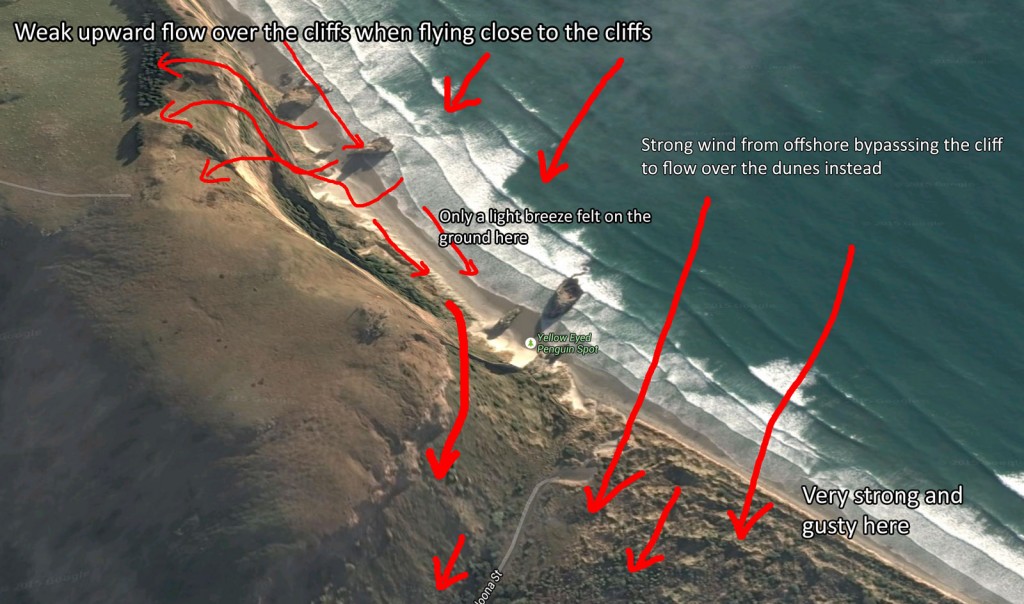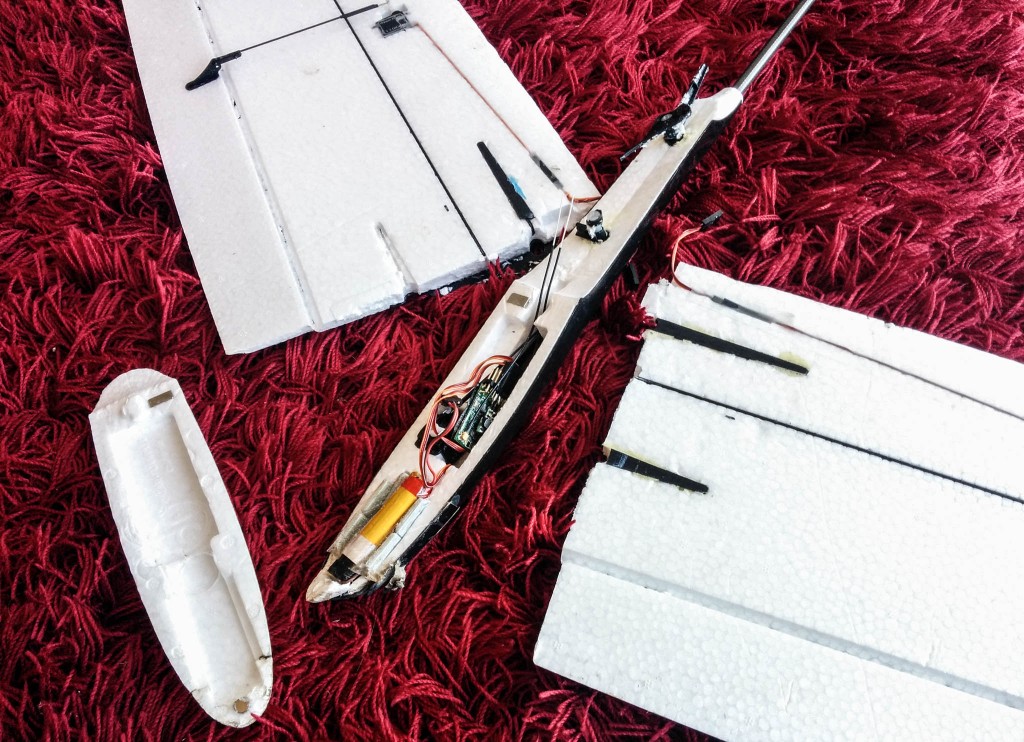Today it was a beautiful blue sunny sky with a reasonable North-East breeze, which means that the wind would be coming directly onshore at Aramoana beach. There is a tall cliff a little back from the water’s edge, and I wanted to try slope soaring on this from its base. However, as I drove out there, the wind speed picked up until I was unsure if I’d be able to fly.
I carried my Libelle over the dunes, fighting with the wind the entire way, a little worried that it would pull the wings off. I finally took off and made a test flight over the dunes. But the wind was too strong, so although I was able to stay in the air, the Libelle’s ground track was continually moving downwind.
I copied some seagulls and moved out from the dunes and onto the beach itself. This was much better, but in the strong wind I still wasn’t getting much lift. I could hardly fly passes along the line of the beach, because I was forced to face almost directly into the wind in order to avoid being blown back into the dunes.
I gave up on flying over the dunes and headed along the beach to the base of the cliff. The strong gusty wind dropped as if I was standing in a sheltered area. I think this is because the cliff forces the air to rise upwards somewhat off-shore, leaving a nearly dead bubble of air at the base of the cliff where I was standing. The wind was even calm enough in this area for a DLG launch, so that’s what I did.
I found a nice steady upward flow of air near the cliffs, so I didn’t have to fight to keep the Libelle pointed where I wanted it. I flew passes along the cliff edge, steadily gaining altitude. I think I eventually managed to climb above the top of the cliff. I had feared that there might be a sudden wind shear at the top of the cliff that would slam me out of sight over the lip of the cliff inland, but luckily this was not the case and there was no discontinuity. A few seabirds joined me in patrolling the beach.
This is where I messed up. I had been soaring out from the cliff towards the water, quite high up so I had to look almost directly upwards to see the Libelle. Then at one point I flew right in front of the sun. This is normally no problem, I just glance away for a second, and then I’ve flown clear of the sun and it’s fine. However this time, as I glanced away, I suddenly realised that the Libelle was facing directly into the onshore wind. So the Libelle would actually be making very little progress across the ground (it was practically hovering in place) and wouldn’t clear the sun nearly as fast as I needed it to. By the time I could see it again, the strong wind could have rotated it into practically any orientation.
By the time I looked back, I couldn’t see the Libelle any more. Bewildered, I searched the whole sky, but there really didn’t seem to be any trace of it. I twitched the controls a little as if it would help me feel where the Libelle was, but to no avail (I need a force-feedback system :)). It really seemed like it had vanished. Finally, 10 or 20 seconds later I heard the unmistakable sound of the Libelle crashing into rock, so I believed that it had crashed into the cliff face, though I didn’t see any wreckage fluttering down to the ground.
I flipped a switch on my Taranis which causes it to announce the RSSI (received signal strength) every 5 seconds, and began to walk up the sand dunes towards the base of the cliff. The initial RSSI reading was about 60, so I knew that the Libelle wasn’t buried too deeply in the sand. Gratifyingly, the RSSI begin to steadily climb with every step I took upwards.
Eventually I found it. It hadn’t crashed into the cliff at all, but rather had crashed into a boulder that was 5-10 metres downslope from the cliff.

Unfortunately it was sitting in a tidy pile of rather more pieces than it took off with. The nose cone is pretty comprehensively smashed, the wings have separated, both dihedral braces have snapped, the wing plate has shattered, and one end of the wing mount has begun to pull vertically out from the foam. One of the aileron servos is completely stripped, while the rudder servo has a notch only at one extreme end of its travel, and could probably fly again. The tailplane and wing surfaces are no uglier than when they took off, and the wing root break is clean and can be easily re-repaired. I think it must have landed nose-first, saving the foam from direct impact.
The peg mounting plate on the right wing was already fractured from a previous incident. Unfortunately, my CA glue repair of this plate must have given way on takeoff (without me noticing) as the launch peg has made a break for freedom and taken the wingtip with it. I don’t know where that ended up.
Unfortunately I think the issues with the wing mount damage, nose cone and missing wingtip are going to keep this Libelle grounded for the moment. Because of the high cost of shipping to New Zealand, I’ve found that the most cost- and time-effective way of buying spare parts is just to order more than one Libelle (particularly for long pieces like the pod/boom assembly or the wing, which require a large shipping box, costing nearly as much as shipping a whole Libelle). So luckily for me I have a pristine, never flown, backup Libelle sitting assembled on the shelf for just this eventuality!
When I lost visual contact with the Libelle, I probably should have gone into a slight bank in the hopes of spiralling to the ground, although the downwind speed was really fierce and it might not have improved things. I’m considering installing a lost-model beeper in future builds, which might have helped locate it in the air as well. Anyway, next time I’m going to stay as far away from the sun as I can!

